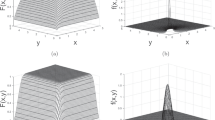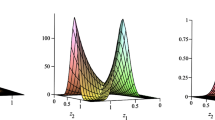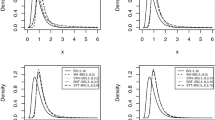Abstract
In this paper, we propose two moment-type estimation methods for the parameters of the generalized bivariate Birnbaum–Saunders distribution by taking advantage of some properties of the distribution. The proposed moment-type estimators are easy to compute and always exist uniquely. We derive the asymptotic distributions of these estimators and carry out a simulation study to evaluate the performance of all these estimators. The probability coverages of confidence intervals are also discussed. Finally, two examples are used to illustrate the proposed methods.




Similar content being viewed by others
References
Aarset MV (1987) How to identify a bathtub shaped hazard rate? IEEE Trans Reliab 36:106–108
Abdous B, Fougères A-L, Ghoudi K (2005) Extreme behaviour for bivariate elliptical distributions. Can J Stat 33:317–334
Azevedo C, Leiva V, Athayde E, Balakrishnan N (2012) Shape and change point analyses of the Birnbaum–Saunders-\(t\) hazard rate. Comput Stat Data Anal 56:3887–3897
Balakrishnan N, Zhu X (2014) An improved method of estimation for the parameters of the Birnbaum–Saunders distribution. J Stat Comput Simul 84:2285–2294
Balakrishnan N, Zhu X (2015) Inference for the bivariate Birnbaum–Saunders lifetime regression model and associated inference. Metrika 78:853–872
Birnbaum ZW, Saunders SC (1969) A new family of life distributions. J Appl Prob 6:319–327
Cambanis S, Huang S, Simons G (1981) On the theory of elliptically contoured distribution. J Multivar Anal 11:365–385
Castro-Kuriss C, Leiva V, Athayde E (2014) Graphical tools to assess goodness-of-fit in non-location-scale distributions. Rev Colomb Stad 37:341–365
Díaz-García JA, Leiva V (2005) A new family of life distributions based on elliptically contoured distributions. J Stat Plan Inference 128:445–457
Fang KT, Kotz S, Ng KW (1990) Symmetric multivariate and related distributions. Chapman and Hall, London
Fisher RA (1921) Frequency distribution of the values of the correlation coefficient in samples from an indefinitely large population. Metron 1:3–32
Johnson RA, Wichern DW (1999) Applied multivariate analysis, 4th edn. Prentice-Hall, New Jersey
Kazemi MR, Jafari AA (2015) Comparing seventeen interval estimates for a bivariate normal correlation coefficient. J Stat Appl Prob Lett 2:1–13
Krishnamoorthy K, Xia Y (2007) Inferences on correlation coefficients: one-sample, independent and correlated cases. J Stat Plan Inference 137:2362–2379
Kundu D, Balakrishnan N, Jamalizadeh A (2010) Bivariate Birnbaum–Saunders distribution and associated inference. J Multivar Anal 101:113–125
Kundu D, Balakrishnan N, Jamalizadeh A (2013) Generalized multivariate Birnbaum–Saunders distributions and related inferential issues. J Multivar Anal 116:230–244
Leiva V, Saulo H, Leao J, Marchant C (2014) A family of autoregressive conditional duration models applied to financial data. Comput Stat Data Anal 9:175–191
Nadarajah S, Kotz S (2008) Estimation methods for the multivariate \(t\) distribution. Acta Appl Math 102:99–118
Ng HKT, Kundu D, Balakrishnan N (2003) Modified moment estimation for the two-parameter Birnbaum–Saunders distribution. Comput Stat Data Anal 43:283–298
Wallgren CM (1980) The distribution of the product of two correlated \(t\) variates. J Am Stat Assoc 75:996–1000
Acknowledgements
Our sincere thanks go to two anonymous referees for their constructive comments on an earlier version of this manuscript which resulted in this improved version. This research work was partially supported by CNPq and CAPES Grants, Brazil.
Author information
Authors and Affiliations
Corresponding author
Appendices
Appendix 1: Asymptotic distribution of the MMEs
Let \({\varvec{T}}=(T_{1},T_{2})^{\top }\) follow a \({\mathrm{GBBS}}({\varvec{\alpha }},{\varvec{\beta }},\rho ,\nu )\) distribution, then
where \(u_{kr}\) is as in (14).
Now, let \(\{(t_{1i},t_{2i}),i=1,\ldots ,n\}\) be a bivariate random sample from the \({\mathrm{GBBS}}({\varvec{\alpha }},{\varvec{\beta }},\rho )\) distribution. The sample arithmetic and harmonic means are defined by
and the MMEs are given by
Consider \(S_{k}=\frac{1}{n}\sum _{i=1}^{n}X_{kj}\) and \(R_{k}^{*}=R_{k}^{-1}=\sum _{i=1}^{n}\frac{1}{X_{ki}} \), with \(k=1,2\), which implies that the vector \((S_{k},R_{k}^{-1})^{\top }\) is bivariate normal distributed, that is,
We need to find the asymptotic joint distribution of \((\tilde{\alpha }_{k},\tilde{\beta }_{k})^{\top }\). Note that
and
By using the Taylor series expansion, we readily have
where
Appendix 2: Asymptotic distribution of \(\widetilde{\alpha }_{k}^{*}\)
Note that
and
where \(\varTheta _{k}=4u_{k1}+(2u_{k2}-u_{k1}^{2})\alpha _{k}^{2}\). From these results, we have
To obtain the distribution of \(\widetilde{\alpha }^{*}_{k}\), we use a Taylor series expansion such that
where \(g'(\cdot )\) and \(g''(\cdot )\) denote the first and second derivatives of the function of \(g(\cdot )\) and \(\xi _{k}=\left( 1+ \frac{u_{k1}}{2}\alpha _{k}^2\right) ^2\). We thus obtain the asymptotic distribution of \(\widetilde{\alpha }_{k}^{*}\) as
Rights and permissions
About this article
Cite this article
Saulo, H., Balakrishnan, N., Zhu, X. et al. Estimation in generalized bivariate Birnbaum–Saunders models. Metrika 80, 427–453 (2017). https://doi.org/10.1007/s00184-017-0612-5
Received:
Published:
Issue Date:
DOI: https://doi.org/10.1007/s00184-017-0612-5




